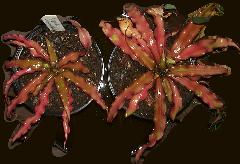


Cryptanthus 'Strawberries Flambe' by Herb Plever in Bromeliana 48(5): 2-3. 2011.
Many plants that I grow under fluorescent lights develop what I consider to be better color and markings than they do when grown in my unobstructed south window in New York.
All of my Cryptanthus show better markings when grown under lights. I don't grow from seed; all of the plants shown are vegetative progeny. They may be many generations removed from their parent, but still they are all progeny of the same original parents. See the photos on this page of Cr. 'Strawberries Flambe'. The original parent that I purchased was similar to the plant (Number 1) many years ago. It had significantly narrower leaves than one of its progeny (Number 2) that was grown close under fluorescent lights with a weekly high strength fertilizer. That plant has intense color and a beautifully compact conformation.
I have recently pumped up that fertilizer regimen for my Crypts with foliar feeding plus pouring fertilizer into the mix. The plant (Number 3) is a progeny of the plant above, several generations removed. It received the stronger fertilizer regimen and perhaps was not grown as close to the fluorescent lights. As a result it has as broad but much longer, more spreading leaves that make a diameter of 15 inches! I think that the increased fertilizer regimen may be too much of a good thing. The plant is too large and I may cut down on the regimen for its pups to bring it back to the tighter shape of the plant (Number 2).
Contrast that plant with the Cryptanthus 'Strawberries Flambe' (Number 4, to 8 inches diam). It was grown in the far corner of my south window. All of the plants in this area are rosettes that receive weekly fertilizer in their cups, so this Cryptanthus 'Strawberries Flambe' received fertilizer only when I remembered to find a sprayer to foliar fertilize it. It has decent but not great color, but its many, shorter leaves create a compact conformation. It is not as dramatic as its siblings grown under lights.
Most pups are like their parent, but in some cultivars (as in this hybrid C. 'Diverse Pink' x C. 'Cascade') can produce offsets with tendencies to produce leaves of diverse colors and shapes, widths and lengths. They may also differ in how they react to the quality and strength of the daylight or fluorescent light they receive. I'd like to repeat that perfect plant (Number 2), but I might have to grow a number of pups to find the "right one".
I use a mix of fluorescent tubes with phosphers that produce color temperatures that approximate that of daylight. Some usually highlight plants attain more dramatic color when grown under those lights, 16 hours a day.